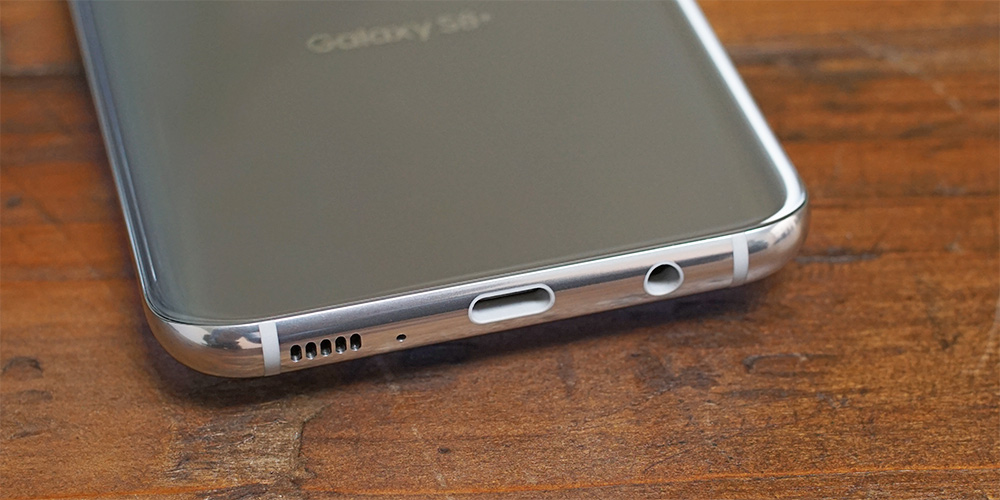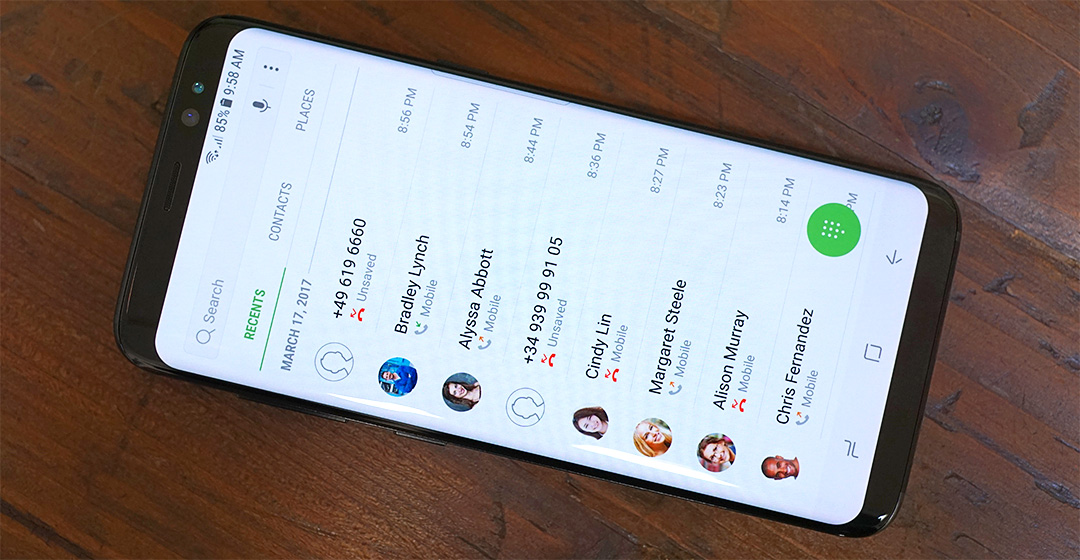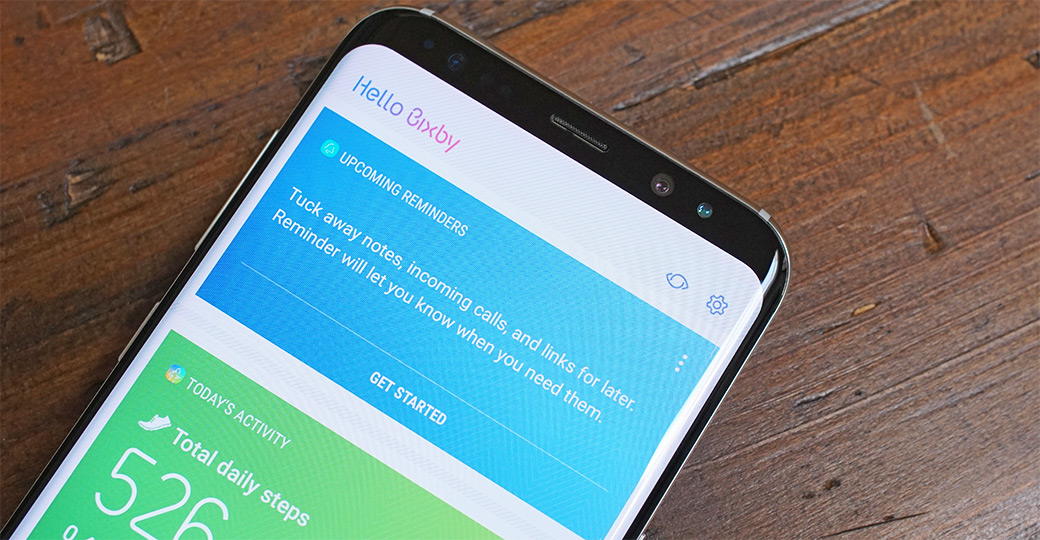Hands On With Samsung's Galaxy S8 and S8+: Taller Screens and Slimmer Bezels
by Matt Humrick on March 29, 2017 11:00 AM EST- Posted in
- Smartphones
- Samsung
- Galaxy
- Mobile
- Galaxy S8

Samsung officially unveiled the latest Galaxy devices at its Unpacked event in New York today. Previous Galaxy phones were part Porsche 911 Carrera, with an easily recognizable curvaceous style, and part Swiss Army knife, bristling with technology and features. This analogy holds true for the 5.8-inch Galaxy S8 and 6.2-inch Galaxy S8+, which share the same design DNA as the previous two generations.
The new phones’ aluminum frame remains sandwiched between edge-to-edge Corning Gorilla Glass 5, with curved sides on the front and back. The curved rear glass makes the phones easier to pick up and more comfortable to hold just as they did for the S7 and S7 edge, while the curved front glass—now standard on both S8 models—adds some visual flair.
There’s not much difference between the S8 and S7 along the sides either. The USB Type-C port on the bottom is flanked by a 3.5mm headphone jack and a single downward-firing speaker. The microSD/NanoSIM combo tray still resides on the top, and the thin power button is still a bit more than halfway up the right side. The only differences between new and old lie on the left side, where the volume buttons have been combined into a single rocker and a dedicated button for launching Samsung’s Bixby assistant makes its debut. Unlike the power button, I found myself occasionally pressing the Bixby button accidentally when picking up the smaller S8.
The most significant change is found up front, however, and it’s one that impacts both form and function. The Galaxy S8 and S8+ adopt Samsung’s new “Infinity Display” that stretches the screen vertically but not horizontally, deviating from the traditional 16:9 aspect ratio. The result is a QHD+ SAMOLED display with a 2960x1440 resolution and an 18.5:9 aspect ratio that’s very similar to the 18:9 aspect ratio display LG is using in its G6. Both Samsung and LG cite market research for this new display direction: People want larger screens that can show more content, but they also want phones that are useable with one hand and can fit in their pocket. The taller screen fits more content, so less scrolling, but keeps the phone narrow, so it’s easier to wrap your hand around.
Both S8 phones incorporate another emerging design trend: rounded display corners. Where LG’s G6 is using an LCD panel that actually has rounded corners, it appears Samsung is using a rounded bezel to cover the S8’s still sharp-cornered display. This avoids the aliasing that’s evident in the G6’s corners, producing a much smoother, nicer looking effect. While my time with the S8 was limited, it appears that TouchWiz and Samsung’s apps were redesigned to account for the rounded corners: Backgrounds extend the full height of the display and visual elements are still displayed along the top and bottom edges without getting cut off. Third-party apps, however, find their vertical dimensions constrained to the purely rectangular portion of the display, with the status bar above and the navigation bar below taking on black backgrounds.
The S8 and S8+ are also the first phones to receive the UHD Alliance’s Mobile HDR Premium certification that ensures a mobile device meets the minimum requirements for playback of 4K HDR video. This means that both S8s are capable of rendering at least 90% of the DCI-P3 color gamut, have a dynamic range of at least 0.0005-540 nits, and support a 10-bit display pipeline.
To keep the overall size of the phones in check, the S8/S8+ and G6 have dramatically reduced the bezel area around the taller screens. Samsung claims a screen-to-body ratio of 83% for its new Galaxy phones, less than the 91.3% of Xiaomi’s Mi MIX concept phone, but impressive nonetheless, especially considering how much hardware is located in the S8’s upper bezel. Besides the usual earpiece and proximity/ambient light sensors, there’s a new 8MP front-facing camera with f/1.7 lens and Smart AF that uses facial recognition for accurate focusing when taking selfies. There’s also an IR LED and IR camera for the iris-scanning security feature that made its debut on the ill-fated Galaxy Note7.
Shrinking the size of the lower bezel required relocating the fingerprint sensor to the back. Instead of placing it below the rear camera like we see on most other phones, Samsung places it next to the flush-mounted camera, which is less than ideal. Both the camera and the sensor are surrounded by a raised lip and are similar in size, making it difficult to locate the sensor by feel, and if your finger misses the sensor, you end up with a nice fingerprint on the camera lens. On the smaller S8, this issue may be mitigated with practice, but the problem is worse for the S8+. Being taller, it places the camera and sensor further from the lower edge, making it very difficult, if not impossible, to reach the sensor when holding the phone with a natural grip. Even with my larger-than-average hands, I struggled to reach the sensor without shifting my grip. I suspect people will turn to the iris scanner or the new face unlock feature, which uses the front camera for facial recognition after pressing the power button, to overcome the poor fingerprint sensor placement. The physical home button and capacitive navigation buttons, iconic Galaxy design features, have also been evicted in favor of the slimmer bezel, replaced by onscreen controls.



















208 Comments
View All Comments
osxandwindows - Wednesday, March 29, 2017 - link
The iphone 8 won't have an edge to edge display, tho.Meteor2 - Wednesday, March 29, 2017 - link
Well it might. The rumoured-to-death 10.5" iPad is supposed to have little or no bezels, even though Apple previously said they'd keep bezels the size they are so people can actually hold tablet computers (I find that useful).Drumsticks - Wednesday, March 29, 2017 - link
"Regardless, it’s disappointing that Samsung is still prioritizing thickness over battery life."This is going to continue until we start getting some real push back, driven, initially probably, by the media.
Seriously Smartphone performance has increased probably nearly an order of magnitude since 2011-12, but we have hardly gotten out of the 1 day of battery life. I seriously think we could tolerate another 2mm of depth in the phone, and I wish the media would make it a bigger deal if you really feel the same way.
Regardless, though, thanks for the hands on! Samsung continues to not be right for me, but the S8 looks like an impressive enough piece of hardware all things considered that should do well for them. I'm a little bit worried about the battery life, with a bigger display, higher resolution, and smaller battery, but I guess we will see.
halcyon - Wednesday, March 29, 2017 - link
Almost all the Chinese competition is doing 4000+ mAh batteris for years now. And their units are just as small, just as light and they don't constantly blow up. And some of them have dual cameras and QHD+ Amoled displays too. Samsung has NO excuse, except pinching pennies. The same for their abysmal flash storage space (all the major competition has gone up to 128/256GB, Samsung in still stuck at 64GB).0iron - Wednesday, March 29, 2017 - link
I think it's more due to the weight. At 155g, it's at certainly upper limit of 'normal' size phone's weight. 173g is also right weight for phablet size. Bigger battery capacity will make total weight less than ideal.Xiaomi Redmi 4 have a 4100mAh battery at 156g.
Notmyusualid - Friday, March 31, 2017 - link
@ 0ironIt IS weight, also in my opinion, my Samsung A9 Pro has a 5000mAh battery, but it is 210g.
http://www.gsmarena.com/samsung_galaxy_a9_pro_(201...
I only put up with it as I was carrying two phones before, which obviously weighed more than 210g.
Meteor2 - Wednesday, March 29, 2017 - link
I think it's too soon to say that Samsung haven't prioritised battery life. Maybe these 10 nm node chips and their new uarches will mean even longer battery lives than before on 3 Ah batteries. When you've got wireless charging and QC, how much battery do you really need? I'm not saying you wouldn't like more, just i that I don't think these phones are badly compromised.lilmoe - Wednesday, March 29, 2017 - link
The DeX interface looks pretty darn fluid and seamless, very fast and responsive too. Definitely looks like a well thought out feature. Love it. But are phone calls managed while docked? Did you get a chance to see that? Is it possible to launch that mode wirelessly and use the phone as a remote touch pad like Windows' implementation?fanofanand - Wednesday, March 29, 2017 - link
This was a refreshing review. Honest criticism without the fanboyishness oftentimes communicated by the "other" mobile phone reviewer.halcyon - Wednesday, March 29, 2017 - link
Did anybody get the impression: wow, nice screen, interesting ratio - meh about the rest?Bixby is work in progress, unproven. Camera is last years single sensor same-o (good enough, but nothing to wow). Nothing special on the audio front (vs. G6 Quad Dac in Asia models). No dual sensors. No big storage space. No big battery. Awkward fingerprint sensor placement.
The whole phone is a great placeholder for an ad titled "Wait till Note8 with better screen, dual cam, more memory and lots of other goodies!"
At 929€, it's a definite pass for me.